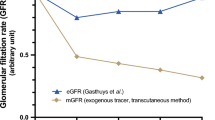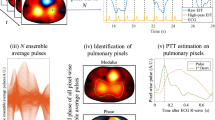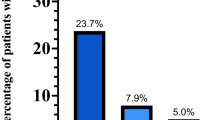Abstract
Persistent pulmonary hypertension is an important cause of mortality and morbidity in term infants. The lung assist device (LAD) is a novel, pumpless, low-resistance extracorporeal oxygenator to supplement mechanical ventilation. The LAD may be associated with fewer complications compared with conventional extracorporeal membrane oxygenation. The objective was to test the feasibility and efficacy of the LAD in juvenile piglets with hypoxia-induced pulmonary hypertension. Pulmonary hypertension was acutely induced by hypoxia in six 3- to 4-wk-old acutely instrumented and intubated piglets. The LAD was attached between a carotid artery and jugular vein. Gas exchange and hemodynamic variables, including pulmonary arterial pressure (PAP) and cardiac output (CO), were measured. Successful LAD cannulation was achieved without complications in all animals. Extracorporeal shunt flow through the device averaged 18% of CO. The LAD achieved oxygen delivery of 20% of total oxygen consumption. PAP was reduced by 35% from 28 ± 5 to 18 ± 4 mm Hg (p < 0.05) and systemic Pao2 increased by 33% from 27 ± 2 to 36 ± 4 mm Hg (p < 0.05). Other hemodynamic variables remained stable. The novel LAD shows feasibility and efficacy in improving gas exchange and reducing PAPs in a juvenile animal model of hypoxia-induced pulmonary hypertension.
Similar content being viewed by others
Log in or create a free account to read this content
Gain free access to this article, as well as selected content from this journal and more on nature.com
or
Abbreviations
- CI:
-
cardiac index
- CO:
-
cardiac output
- ECMO:
-
extracorporeal membrane oxygenation
- LAD:
-
lung assist device
- PPHN:
-
persistent pulmonary hypertension of the newborn
- PAP:
-
pulmonary arterial pressure
- PVRI:
-
pulmonary vascular resistance index
- VO2:
-
oxygen consumption
References
Walsh-Sukys MC, Tyson JE, Wright LL, Bauer CR, Korones SB, Stevenson DK, Verter J, Stoll BJ, Lemons JA, Papile LA, Shankaran S, Donovan EF, Oh W, Ehrenkranz RA, Fanaroff AA 2000 Persistent pulmonary hypertension of the newborn in the era before nitric oxide: practice variation and outcomes. Pediatrics 105: 14–20
Konduri GG 2004 New approaches for persistent pulmonary hypertension of newborn. Clin Perinatol 31: 591–611
UK Collaborative ECMO Trial Group 1996 UK collaborative randomised trial of neonatal extracorporeal membrane oxygenation. Lancet 348: 75–82
Kinsella JP, Truog WE, Walsh WF, Goldberg RN, Bancalari E, Mayock DE, Redding GJ, de Lemos RA, Sardesai S, McCurnin DC 1997 Randomized, multicenter trial of inhaled nitric oxide and high frequency oscillatory ventilation in severe, persistent pulmonary hypertension of the newborn. J Pediatr 131: 55–62
1997 Inhaled nitric oxide in full-term and nearly full-term infants with hypoxic respiratory failure. The Neonatal Inhaled Nitric Oxide Study Group. N Engl J Med 336: 597–604
Clark RH, Gertsmann DR, Jobe AH, Moffitt St, Slutsky AS, Yoder BA 2001 Lung injury in neonates: causes, strategies for prevention, and long-term consequences. J Pediatr 139: 478–486
Zwischenberger JB, Nguyen TT, Upp JR Jr, Bush PE, Cox CS Jr, Delosh T 1994 Complications of neonatal extracorporeal membrane oxygenation: collective experience from the extracorporeal life support organization. J Thorac Cardiovasc Surg 107: 838–849
Plotz FB, van Oeveren W, Bartlett RH, Wildevuur CR 1993 Blood activation during neonatal extracorporeal life support. J Thorac Cardiovasc Surg 105: 823–832
Hirthler MA, Blackwell E, Abbe D, Doe-Chapman R, Le Clair Smith C, Goldthorn J, Canizaro P 1992 Coagulation parameter instability as an early predictor of intracranial hemorrhage during extracorporeal membrane oxygenation. J Pediatr Surg 27: 40–43
Stallion A, Cofer BR, Rafferly JA, Ziegler MM, Ryckman FC 1994 The significant relationship between platelet count and haemorrhagic complications on ECMO. Perfusion 9: 265–269
Iglesias M, Junglebluth P, Petit C, Matute MP, Rovira I, Martinez E, Catalan M, Ramirez J, Macchiarini P 2008 Extracorporeal lung membrane provides lung protection than conventional treatment for severe postpneumonectomy noncardiogenic acute respiratory distress syndrome. J Thorac Cardiovasc Surg 135: 1362–1371
Nielsen ND, Kjaergaard B, Koefoed-Nielsen J, Steensen CO, Larsson A 2008 Apneic oxygenation combined with extracorporeal arteriovenous carbon dioxide removal provides sufficient gas exchange in experimental lung injury. ASAIO J 54: 401–405
Dembinski R, Hochhausen N, Terbeck S, Uhlig S, Dassow C, Schneider M, Schachtrupp A, Henzler D, Rossaint R, Kuhlen R 2007 Pumpless extracorporeal lung assist for protective mechanical ventilation in experimental lung injury. Crit Care Med 35: 2359–2366
Zick G, Frerichs I, Schädler D, Schmitz G, Pulletz S, Cavus E, Wachtler F, Scholz J, Weiler N 2006 Oxygenation effect of interventional lung assist in a lavage model of acute lung injury: a prospective experimental study. Crit Care 10: R56
Flörchinger B, Philipp A, Flose A, Hilker M, Kobuch R, Rupprecht L, Keyer A, Pühler T, Hirt S, Wiebe K, Müller T, Langgartner J, Lehle K, Schmid C 2008 Pumpless extracorporeal lung assist: a 10-year institutional experience. Ann Thorac Surg 86: 410–417
Hommel M, Deja M, von Dossow V, Diemel K, Heidenhain C, Spies C, Weber-Carstens S 2008 Bronchial fistulae in ARDS patients: management with an extracorporeal lung assist device. Eur Respir J 32: 1652–1655
Walles T 2007 Clinical experience with the iLA membrane ventilator pumpless extracorporeal lung-assist device. Expert Rev Med Devices 4: 297–305
Zimmermann M, Philipp A, Scmid FX, Dorlac W, Arlt M, Bein T 2007 From Baghdad to Germany: use of a new pumpless extracorporeal lung assist system in two severely injured US soldiers. ASAIO J 53: e4–e6
Bein T, Scherer MN, Philipp A, Weber F, Woertgen C 2005 Pumpless extracorporeal lung assist (pECLA) in patients with acute respiratory distress syndrome and severe brain injury. J Trauma 58: 1294–1297
Fazzalari FL, Montoya JP, Bonnell MR, Bliss DW, Hirschl RB, Bartlett RH 1994 The development of an implantable artificial lung. ASAIO J 40: M728–M731
Lynch WR, Montoya JP, Brant DO, Schreiner RJ, Iannettoni MD, Bartlett RH 2000 Hemodynamic effect of a low-resistance artificial lung in series with the native lungs of sheep. Ann Thorac Surg 69: 351–356
Lick SD, Zwischenberger JB, Alpard SK, Witt SA, Deyo DM, Merz SI 2001 Development of an ambulatory artificial lung in an ovine survival model. ASAIO J 47: 486–491
Lick SD, Zwischenberger JB, Wang D, Deyo DM, Alpard SK, Chambers SD 2001 Improved right heart function with a compliant inflow artificial lung in series with the pulmonary circulation. Ann Thorac Surg 72: 899–904
Zwischenberger JB, Wang D, Lick SD, Deyo DJ, Alpard SK, Chambers SD 2002 The paracorporeal artificial lung improves 5-day outcomes from lethal smoke/burn-induced acute respiratory distress syndrome in sheep. Ann Thorac Surg 74: 1011–1016
Sato H, Griffith GW, Hall CM, Toomasian JM, Hirschl RB, Bartlett RH, Cook KE 2007 Seven day artificial lung testing in an in-parallel configuration. Ann Thorac Surg 84: 988–994
Sato H, Hall CM, Lafayette NG, Pohlmann J, Padiyar N, Toomasian JM, Haft JW, Cook KE 2007 Thirty-day, in parallel artificial lung testing in sheep. Ann Thorac Surg 84: 1136–1143
Institute of Laboratory Animal Research Commission on Life Sciences, National Research Council 1997 The Guide for the Care and Use of Laboratory Animals 7th ed. National Academy Press, Washington D.C
Ambalavanan N, Bulger A, Murphy-Ullrich J, Oparil S, Chen YF 2005 Endothelin-A receptor blockade prevents and partially reverses neonatal hypoxic pulmonary vascular remodeling. Pediatr Res 57: 631–636
Ambalavanan N, Philips JB III, Bulger A, Oparil S, Chen YF 2002 Endothelin-A receptor blockade in porcine pulmonary hypertension. Pediatr Res 52: 913–921
Ambalavanan N, Bulger A, Ware J, Philips JB III 2001 Hemodynamic effects of levcromakalin in neonatal porcine pulmonary hypertension. Biol Neonate 80: 74–80
Author information
Authors and Affiliations
Corresponding author
Additional information
Supported in part by PHA 0526041H, K08 HD 046513, R01 HL092906, and a grant from the Children's Center for Research and Innovation.
The authors declare no conflict of interest.
Rights and permissions
About this article
Cite this article
El-Ferzli, G., Philips, J., Bulger, A. et al. Evaluation of a Pumpless Lung Assist Device in Hypoxia-Induced Pulmonary Hypertension in Juvenile Piglets. Pediatr Res 66, 677–681 (2009). https://doi.org/10.1203/PDR.0b013e3181bbc7ec
Received:
Accepted:
Issue date:
DOI: https://doi.org/10.1203/PDR.0b013e3181bbc7ec



